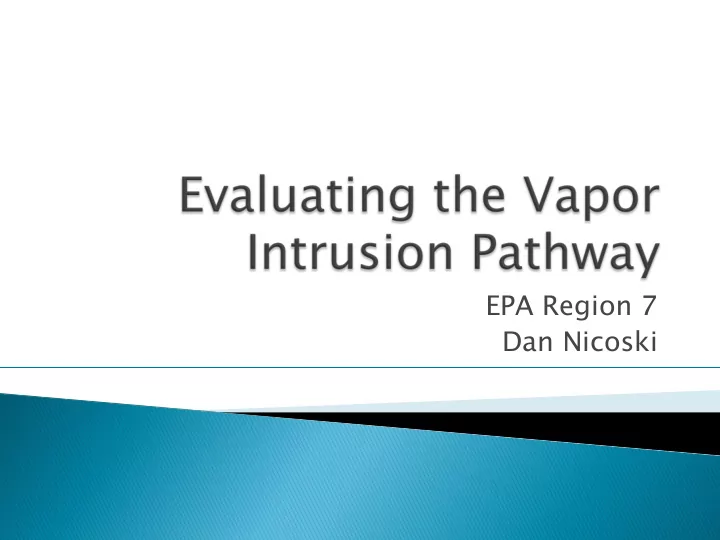

EPA Region 7 Dan Nicoski
} EPA Region 7 approach to evaluating the VI Pathway } Using the VISL Calculator } Why Pre-emptive Mitigation? } New ORD VI Documents
} EP EPA R7 recommended approach… … Sub-slab/Indoor Air/Ambient t Air/Survey } Sub-slab only ◦ Indicator of potential VI concerns ◦ Can’t fully evaluate the VI pathway } Indoor Air only ◦ Must assume any detects are from the subsurface ◦ Evaluate potential indoor sources ◦ Contributions from outdoor air? } Sub-slab/Indoor Air – VI pathway evaluated; what about outdoor contributions?
} Exterior Soil Gas ◦ Provides an additional line of evidence ◦ Collect samples at depth of foundation or 5 ft whichever is deeper & on multiple sides of structure ◦ Evaluate attenuation; collect soil vapor samples from various interval(s) ◦ Near source/exterior soil vapor concentrations may not represent concentrations under structure ◦ Due to this potential effect, any detections above the 1E-06 cancer risk value will warrant IA/SS sampling
} Typically recommend 4 quarterly sampling events; co-located/concurrent SS/IA } Spatial & temporal variability } Active sampling - Summa or sorbent tubes } Industrial ◦ Greater slab thickness than residential ◦ Higher air exchange rates ◦ Building construction – OH doors, vents & fans, HVAC systems, more open areas ◦ Building use – sensitive populations, office settings, chemical use or storage ◦ Provides RPs with data to evaluate work place exposures
} Groundwater } Groundwater – 0.001 ◦ generic - 0.001 } Sub-slab/soil gas ◦ fine grained - 0.0005 ◦ shallow - 0.1 } Sub-slab – 0.03 ◦ deep – 0.01 } Exterior Soil Gas – 0.03 } Exterior Soil Gas – SAA } Crawl Space – 1 } Crawl Space = soil gas 2002 Draft VI Guidance 2015 VI Guidance
} Identifies chemicals of sufficient volatility & toxicity } Provides updated RSL concentrations } Facilitates calculation of site-specific screening levels } Ensure use of the appropriate exposure scenario, risk value, SS-IA, GW-IA, groundwater temperature & attenuation factor
} Subsurface contaminants may indicate potential vapor intrusion concerns } Sensitive populations – daycare, senior living center, elementary school } Cost-effective means of protecting human health } Reduce potential risks of indoor air exposure due to prolonged study periods
} Monitoring the VMS ◦ Collect indoor air samples after installation ◦ Evaluate pressure measurements } Operation and maintenance of VMS ◦ Periodic routine inspections/repair/ replacement ◦ Fans, piping, seals & membranes } Termination/Exit Strategy ◦ Operates until source remediated to clean-up levels ◦ Sample sub-slab/indoor air to verify above
} Assessment of Mitigation Systems on VI: Temporal trends, Attenuation Factors, and Contaminant Routes under Mitigated & Non- Mitigated Conditions; EP EPA/600/R-13/241, June 2015. } Simple, Efficient, & Rapid Methods to determine the Potential for VI into the Home: Temporal Trends, VI Forecasting, Sampling Strategies, & Contaminant Routes; EP EPA/600/ R- R-15/070 15/070, October 2015.
} No apparent effects of rain on VI sampling; snowfall & snow/ice accumulation can increase VOC VI. } VMS are highly effective on radon (>90%) but not as effective on VOCs (~60%). } Interactive effect of cold temps, snowfall/ice, barometric pressure and wind load on VOC VI; perhaps up to 10 factors (build construction, geology, DTW, preferential pathways, etc.). } Tracer studies suggest horizontal migration from up to 20 ft; vertical migration from 13 ft to 6 ft.
} Reasonable agreement between observed deep soil gas concentrations and those predicted by Henry’s Law from groundwater. } Collection of two VI samples in winter (one early, one late) may provide a reasonable prediction of near-term/worst-case VI. } The ability of human experts to effectively predict such a complex multivariable process is expected to be limited.
Recommend
More recommend